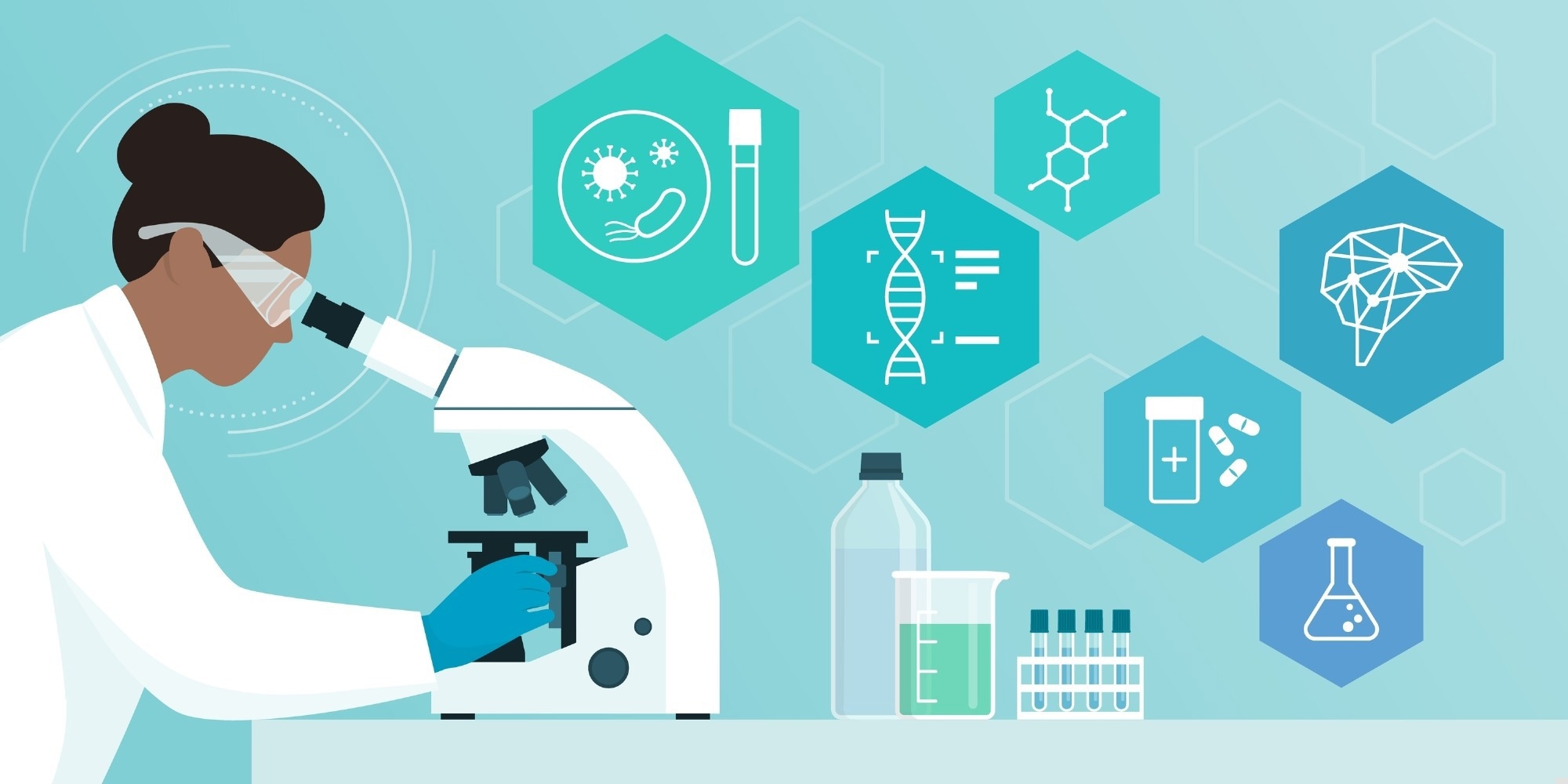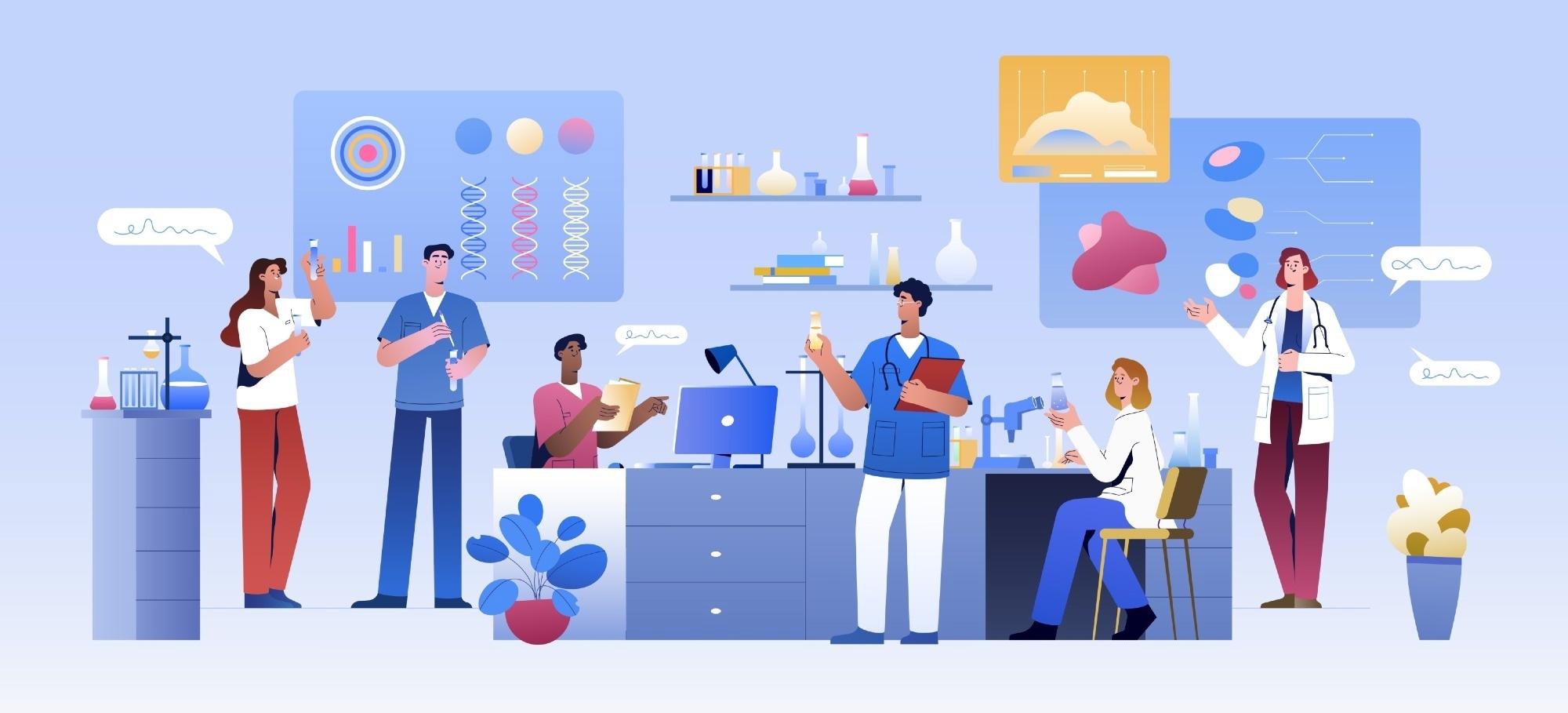Introduction to pharmaceutical R&D
What is pharmaceutical R&D?
Key stages of pharmaceutical R&D
Conclusion
References
Further reading
Introduction to pharmaceutical R&D
In 2022, the combined research and development (R&D) expenditure of the U.S. pharmaceutical industry consisted of more than $100 billion. While this is a significantly expansive market, approximately less than 30 percent of new drugs progress from Phase II to Phase III clinical trials successfully.1
Developing new drugs from the discovery stage to the launching of the product into the market is a lengthy and complex process, taking approximately 12-15 years and costing over $1 billion.2
Pharmaceutical R&D plays an important role in discovering new or improved methods to optimize therapeutic approaches and address unmet medical needs. This increases overall public health and ensures healthcare professionals can provide better care for their patients.3 This article will explore the role of pharmaceutical R&D further.

Image Credit: elenabsl/Shutterstock.com
What is pharmaceutical R&D?
Pharmaceutical research, which involves drug development, aims to investigate drug interaction with living organisms. Some significant pharmaceutical products developed in the past include insulin and penicillin in the 1920s and 1930s, which greatly improved population health.4
The historical concept behind this process involves isolating the active ingredient from conventional remedies or discovering a therapeutic effect of a drug by chance. The second method results in a few potential drug candidates that reach the open market.4
With the growth of this sector and advanced processes to expedite finding potential drug candidates, regulatory oversight was required to reduce the occurrence of life-threatening incidents from the development and use of pharmaceutical drugs.4
The pharmaceutical R&D industry began to grow substantially in the 1990s, with various partners being involved in the process, including the National Institutes of Health (NIH) in the United States and academia, which furthered the research stages of drug development into a more rigorous process over the subsequent years.4
Key stages of pharmaceutical R&D
Discovery phase
Drug development starts with the discovery phase, with new knowledge of a biological target such as a receptor, enzyme, protein, or gene that is involved with a biological process that may not be working effectively in patients.5
This phase encompasses the discovery of new medicine with a mode of action that works differently from already approved medicines and for a different clinical indication. The newly approved medications may provide additional benefits to existing medications, such as safety, potency, tolerability, or convenience.5
At this early stage of drug discovery, researchers compile thousands of compounds that may be potential drug candidates for medical treatment. However, after early testing of these compounds, only a small volume is deemed to be promising enough for further examination.6
Target identification and validation involves genetic, cellular, and experimental models that identify and validate the biological targets identified by researchers. This is a significant step for drug development, reducing the risk of producing an ineffective drug. The two main reasons drugs fail in the clinic are: (i) they either do not work or (ii) they are unsafe.2
A good target is required to be effective, safe, meet clinical and commercial needs, and be ‘druggable,’ meaning it causes a biological response that can be measured both in vitro (a laboratory test performed outside of the body7) and in vivo (a laboratory test performed on whole living organisms, i.e., in the body8).2
Once a potential drug candidate has been found, it will progress onto the next stage of pre-clinical research for further testing.2
Preclinical research
Prior to drug testing in humans, researchers are required to investigate a drug’s potential to cause serious harm or toxicity through preclinical research, including in vitro and in vivo testing.9
In vitro cell studies are typically the first tests performed on a potential drug candidate to investigate its efficacy. Researchers investigate the effects of the new drug on human or animal cells that are grown in a petri dish or test tube.10

Image Credit: redgreystock/Shutterstock.com
After evaluating which treatments work well in cell studies, researchers perform in vivo testing in live animals, which provides information about the safety of the new treatment in a living organism.10
Clinical trials
Clinical trials are a significant part of pharmaceutical R&D and are conducted with questions and objectives that require answering before being approved by the Food and Drug Administration (FDA).10
There are four stages of clinical trials, including Phase I, II, III, and IV.10
Phase I clinical trials aim to investigate the safety of a new drug treatment. Within this phase, researchers identify the highest safe dose that can be administered to patients without severe side effects. While Phase I trials have the highest potential risk for patients, they do, however, help some patients who are facing life-threatening diseases.10,11
Phase II clinical trials aim to investigate the efficacy and side effects of the drug in a group of 25 to 100 patients. When developing a cancer treatment, this phase assesses if the treatment works in certain types of cancers. In Phase II trials, everyone typically receives the same dosage. However, in some trials, patients may be randomly assigned to different treatment groups with different dosages to assess the best balance of safety and response.10,11
Phase III clinical trials investigate whether the new drug treatment is better than drugs that are already available. This phase compares the safety and efficacy of a new drug treatment against a placebo or a current standard of care treatment. Ethically, while placebos can be used in some phase III trials, they are never used alone if there is an effective standard of care treatment.10,11
Randomization can be used to assign patients to either the new drug group or to the standard of care treatment that is already approved. A double-blind design can also be used to prevent the doctors and patients from knowing which treatment they are receiving.10
After Phase III clinical trials, regulatory agencies such as the US FDA and the European Medicines Agency (EMA) assess new drug treatments with high efficacy or safety results. These agencies play an integral role in introducing new drugs into clinical practice worldwide.12
Both regulatory agencies have assessment criteria that a drug is required to meet before approval is granted, such as investigating a drug’s ability to address an unmet medical need, having meaningful benefits over available drugs on the market, and benefiting public health.12
Phase IV clinical trials can be described as post-marketing surveillance trials that aim to assess drugs that have already received regulatory approval after Phase III trials.13
These trials evaluate how a drug works over a longer period while being available on the market, with doctors prescribing the drug to a wider population of patients. As a result, researchers can understand the full effect of the drug and gain a holistic view of its wider impact.10
Phase IV studies may also investigate other factors that affect treatment, including quality of life or cost effectiveness.10
Does pharmaceutical R&D investment correlate with new medicines?
Conclusion
Pharmaceutical R&D encompasses all stages of drug discovery and development and plays a significant role in how novel drug treatments are made available on the market for the benefit of public health.3
From target identification and validation to preclinical trials, clinical trials, and post-market surveillance, pharmaceutical R&D provides due diligence and evidence for the efficacy and safety of innovative treatments before and after regulatory approval.3,10
References
- Pharmaceutical research and development (R&D). Statista. https://www.statista.com/topics/6755/pharmaceutical-research-and-development-randd/#topicOverview
- Hughes J, Rees S, Kalindjian S, Philpott K. Principles of Early Drug Discovery. British Journal of Pharmacology. 2011;162(6):1239-1249. doi: https://doi.org/10.1111/j.1476-5381.2010.01127.x
- Chandra A, Drum J, Daly M, et al. Comprehensive measurement of biopharmaceutical R&D investment. Nature Reviews Drug Discovery. Published online August 6, 2024. doi:https://doi.org/10.1038/d41573-024-00131-2
- Wang ML. The Modern Pharmaceutical Industry: History, Current Position and Challenges. Global Health Partnerships. Published online 2009:33-80. doi:https://doi.org/10.1057/9780230582873_2
- Mohs RC, Greig NH. Drug discovery and development: Role of basic biological research. Alzheimer’s & Dementia: Translational Research & Clinical Interventions. 2017;3(4):651-657. doi:https://doi.org/10.1016/j.trci.2017.10.005
- FDA. Discovery and Development. U.S. Food and Drug Administration. Published January 4, 2018. https://www.fda.gov/patients/drug-development-process/step-1-discovery-and-development
- NCI Dictionaries. In Vitro. Available from: https://www.cancer.gov/publications/dictionaries/cancer-terms/def/in-vitro. Published February 2, 2011.
- NCI Dictionaries. In Vivo. https://www.cancer.gov/publications/dictionaries/cancer-terms/def/in-vivo. Published February 2, 2011.
- FDA. Step 2: Preclinical Research. U.S. Food and Drug Administration. Published 2018. https://www.fda.gov/patients/drug-development-process/step-2-preclinical-research
- American Cancer Society. Types and Phases of Clinical Trials | What Are Clinical Trial Phases? www.cancer.org. Published August 18, 2020. https://www.cancer.org/cancer/managing-cancer/making-treatment-decisions/clinical-trials/what-you-need-to-know/phases-of-clinical-trials.html
- FDA. Step 3: Clinical Research. U.S. Food and Drug Administration. Published January 4, 2018. https://www.fda.gov/patients/drug-development-process/step-3-clinical-research
- Hwang TJ, Ross JS, Vokinger KN, Kesselheim AS. Association between FDA and EMA expedited approval programs and therapeutic value of new medicines: retrospective cohort study. BMJ. Published online October 7, 2020:m3434. doi:https://doi.org/10.1136/bmj.m3434
- Fountzilas E, Tsimberidou AM, Vo HH, Kurzrock R. Clinical trial design in the era of precision medicine. Genome Medicine. 2022;14(1). doi:https://doi.org/10.1186/s13073-022-01102-1
Further Reading
Last Updated: Aug 12, 2024